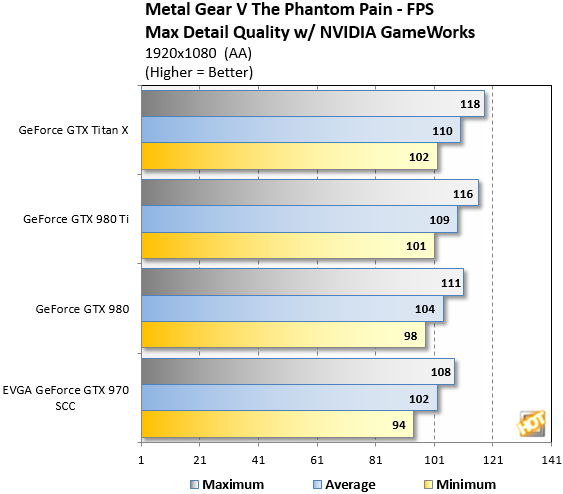Metal Gear Solid V: The Phantom Pain is a feast for the eyes. Fans of the series will remember Ground Zeroes launched on PC about nine months after its console release. In that time the dev team was able to toss in several substantial enhancements to the game’s Fox Engine for the PC release of Ground Zeroes and Phantom Pain. The most notable is its support for resolutions beyond the PS4 constraints, supporting 2560x1440, 3840x2160 (4K) and even 5K resolutions. The game features higher quality shading effects and full support for PC-specific NVIDIA GameWorks effects. Volumetric clouds, ambient occlusion, depth of field and post-processing effects are also supported.

Players will also enjoy and contend with the game’s dynamic weather, which makes use of a working cloud system and can produce scalable weather effects based on detail settings chosen by the user. It all comes together quite nicely. The sprawling deserts and dunes show sand rolling over them as the wind blows. The lighting and dynamic weather not only add to the immersion but are also nicely animated. Sandstorms particularly are a force to be reckoned with. The game also features a day-to-night cycle transition, which looks stellar. Yet it requires you to choose your insertion/deployment time wisely. There is so much going on in a given mission and it all looks fabulous.

A Few Data Points On Performance -
Metal Gear Solid V: The Phantom Pain does not feature a built-in benchmark tool for us to leverage. For these tests we did a little riding around on horse back and in a jeep through enemy camps, where texture and particle details are at their most demanding.
We repeated this several times noting the results with Fraps. Now lets see how our cache of NVIDIA-based GPUs handles MGSV PP.



On the performance front, PC gamers really lucked out here. As seen above, Metal Gear Solid V The Phantom Pain is not incredibly demanding, scales well and can be enjoyed on midrange spec’d systems. The developers have locked frame rate performance at 60FPS. In fact, most of our playtime was conducted on an older EVGA GTX 970 SSC video card. In our entire play session, we experienced only a single lock-up, which prompted a system restart. The game is locked at 60FPS max by default but a simple file config edit will unlock things nicely. Any changes to the in-game settings will automatically revert the settings back to their default values, however. Be prepared to re-edit that config file. Nonetheless, we still see wholly playable setting all around. The EVGA 970 SSC shows its limitations in the 4K test, but stands strong otherwise. If you are working with the equivalent or better then you're all set and graphics cards with less horsepower should be able to handle max image quality settings like we chose above, all the way up to 1440p resolutions.










